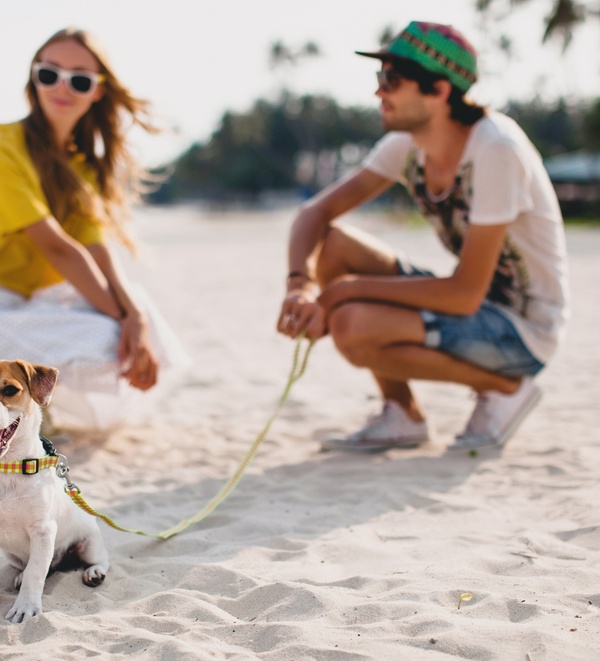
Water Safety for Dogs: Tips to Keep Your Pup Safe Around Water
Planning a sun-soaked day by the water with your furry friend? Whether you're lounging by the pool, heading to the beach, or setting sail on a boat trip, a little preparation goes a long way in keeping your dog safe, comfortable, and — most importantly — happy!
Before you make a splash, brush up on these essential dog water safety tips.
POOL SAFETY FOR DOGS
While pools might seem like the perfect place to cool off, they can actually pose hidden risks for your dog. Here’s how to make sure your pup enjoys the pool safely:
Supervise at All times
Even if your dog loves the water, don�’t assume they’re a natural swimmer. Always keep a close eye on them while they’re splashing around. Swimming is hard work, so encourage frequent rest breaks and be ready to step in if they look fatigued or stressed.
Teach Them a Safe Pool Exit
Knowing how to get out of the pool independently is crucial for your dog’s safety. Install a pet-friendly ramp or train them to use the pool steps confidently. Practice with them multiple times, so finding the exit becomes second nature.
Discourage Drinking Pool Water
It might seem harmless, but chlorinated pool water can upset your dog's stomach and, in large amounts, lead to more serious health issues. Always have a bowl of fresh, clean water nearby to keep them hydrated and less tempted to drink from the pool.
Be Sure to Rinse Off Your Dog
After pool time, give your dog a quick rinse with fresh water. Chlorine and other chemicals can irritate their skin and coat, causing dryness or allergic reactions. A thorough rinse helps keep their coat healthy and prevents itchiness or discomfort later.
Don’t forget: Not all pups are natural swimmers. Some breeds with shorter legs and larger bodies — like pugs, French bulldogs, and corgis — may prefer to just spend the day lounging poolside.
BOATING WITH DOGS: HOW TO SET SAIL SAFELY
Dog boating adventures can be a blast, but they’re even more fun when you’re properly prepared. Here’s how to keep your furry friend safe while boating:
Suit Up With a Dog Life Jacket
Even strong swimmers benefit from a well-fitted dog life jacket. Life jackets provide buoyancy and peace of mind. Choose a bright color for visibility and one with a handle so you can easily lift your pup back onto the boat if needed.
Create a Comfort Zone
Boats can heat up quickly under the sun. Make sure your dog has a shaded area to escape the heat and plenty of fresh water to stay hydrated. Bring a non-slip mat or soft bed for them to lie on, so they feel secure and comfortable.
Ease Them In
If it’s your dog’s first time on a boat, take it slow. Start with short trips to help them adjust to the new sights, smells, and sensations. Slowly build up their comfort level before attempting longer outings.
Watch Out for Dog Motion Sickness
Dogs can get seasick, too! Signs include drooling, whining, panting, shaking, vomiting, and diarrhea. If you notice any symptoms, cut the trip short and consult your vet about potential remedies for future outings.
HEADING TO THE BEACH?
From lakes to oceans, remember these key things to help keep your dog safe and healthy around any body of water:
Let Them Go at Their Own Pace
Some dogs charge right into the water, while others might need a little time to warm up. Always let your pup explore the water on their own terms. Forcing them can create fear and negative associations with water play.
Mind the Salt
Saltwater might seem harmless, but drinking too much can lead to dehydration and an upset stomach from bacteria and parasites. Be especially cautious with energetic swimmers who tend to gulp water as they play. Offer plenty of fresh, clean drinking water and encourage regular breaks to rest and rehydrate.
Watch Out for Beach Hazards
Beaches are beautiful, but they’re also full of hidden surprises. Broken shells, sharp rocks, jellyfish, and even discarded trash can injure your dog’s paws or cause illness if ingested. Stay alert and steer your dog away from anything suspicious or harmful.
Dry Their Ears
Excess moisture can lead to painful ear infections, especially in floppy-eared breeds like retrievers and spaniels. After swimming, gently dry their ears with a towel. If your dog is prone to ear issues, talk to your vet about using a drying solution designed specifically for pets.
Don’t Forget Your Pet First Aid Kit
Accidents can happen even during the best beach days, and having the right supplies on hand can make all the difference in treating minor injuries quickly. Pack a pet-friendly first aid kit with essentials like antiseptic wipes, bandages, tweezers (for removing debris like thorns or splinters), and an emergency vet contact number.
DON’T FORGET TO HAVE FUN
Whether your pup is a seasoned swimmer or getting their paws wet for the first time, a little mindfulness and planning can help make their adventures safer and more fun.
ASK THE VET: DOG WATER SAFETY FAQs
Do all dogs know how to swim?
No, not all dogs are natural swimmers. Breeds with short legs, large chests, or flat faces — like pugs, French bulldogs, and corgis — often struggle in the water. Always supervise your dog and use a life jacket when in doubt.
Does my dog need a life jacket?
Yes, life jackets are highly recommended, especially for boating, open water, or if your dog is not a confident swimmer. Look for one with a handle and bright colors for visibility and safety.
Is it safe for dogs to swim in a pool?
Yes, but pools can pose risks. Teach your dog how to exit safely, prevent them from drinking chlorinated water, and rinse them off afterward to protect their skin and coat.
Can dogs get sick from drinking ocean or lake water?
Yes. Saltwater can cause dehydration and stomach issues, while lakes may contain bacteria or parasites. Always provide fresh drinking water and monitor your dog closely.
How can I keep my dog safe on a boat?
Make sure your dog wears a life vest, stays hydrated, and has shade and non-slip footing. Gradually get them used to the boat and watch for signs of motion sickness.
What should I pack for a day at the beach with my dog?
Essentials include a bowl, fresh water, an umbrella, a towel, a dog life jacket, a first aid kit, and poop bags. Plus, be sure not to forget plenty of toys and treats!
What are signs of water fatigue in dogs?
Signs include heavy panting, slowing down, frantic paddling, or trying to exit the water. Always supervise and encourage rest breaks to prevent exhaustion or panic.
How do I teach my dog to be safe around water?
Start slow, use positive reinforcement, train them to exit pools safely, and never force them into water. Build their confidence over time in a safe, calm environment.
Have more questions about dog water safety? Book an appointment with your vet to get personalized advice and make sure you and your pets are prepped for the summer.
About the Author
